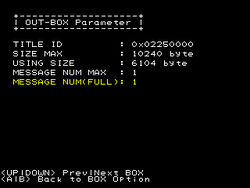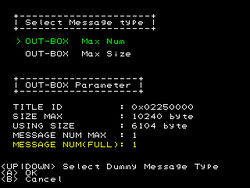3DS Development Unit Software: Difference between revisions
Meleemeister (talk | contribs) →Friend Add Tool: fixed media link |
|||
| (22 intermediate revisions by 7 users not shown) | |||
| Line 6: | Line 6: | ||
=System Updaters= | |||
[[File:CSUscrnshot.png|300px|thumb|right|CSU Screenshot]] | |||
There are two kinds of system updaters for dev (panda) units, CTR System Updater (CSU) and SNAKE System Updater. As the names imply, the former is for original 3DS and the latter is for New 3DS. They are used to update the panda unit's 'firmware'/SDK Version. The romfs of the CSU contains the contents that will be installed to NAND. They contain all system titles as well as Devmenu and Config. | |||
| Line 16: | Line 20: | ||
== Home Menu== | |||
[[File:CTR_HMN_DEV_CPU.png|300px|thumb|right|3DS Dev Homemenu]] | |||
The 3DS Dev Homemenu have some features that the retail one don't have. | |||
*Debug informations (top screen left, can be shown by pressing X+Y): | |||
:*Banner region (have every regions and languages, can be changed by pressing B+X), | |||
:*Build date, | |||
:*Homemenu rev, | |||
:*System mode (see config system mode for more infos), | |||
:*Screen capture (seems to be only for ctr debugger?), | |||
:*First red bar: Maximum level for the other bars (100%), | |||
:*Second bar: CPU processing, | |||
:*Third bar: GPU processing. | |||
*Themes: | |||
:The Dev Homemenu can load themes in SD:/theme/(theme name)/(theme files). | |||
:Note that retail themes and setting dev themes in random don't work. | |||
*Icon database and icon cache: | |||
:You can delete them by holding X+Y button while booting homemenu. | |||
== Dev Menu == | == Dev Menu == | ||
[[File:Devmenuicon.png|||left]] | [[File:Devmenuicon.png|||left]] | ||
| Line 28: | Line 48: | ||
[[File:Old_Dev_Menu.png|200px|thumb|right|Old Dev Menu Screenshot]] | [[File:Old_Dev_Menu.png|200px|thumb|right|Old Dev Menu Screenshot]] | ||
This application on the top screen displays the firmware and revision of the Dev Menu, the free space available on the [[Flash Filesystem#TWL partition|TWL(DSi) NAND partition]] and [[SD Filesystem|SD card]] if present. It also provides information on the current file or device selected, as well as navigation instructions for the bottom screen.The bottom screen has three different windows, which are: | This NAND application (00040000-0ff40002) on the top screen displays the firmware and revision of the Dev Menu, the free space available on the [[Flash Filesystem#TWL partition|TWL(DSi) NAND partition]] and [[SD Filesystem|SD card]] if present. It also provides information on the current file or device selected, as well as navigation instructions for the bottom screen.The bottom screen has three different windows, which are: | ||
*Program - From this tab, applications can be loaded from the [[Flash Filesystem|NAND]], the [[SD Filesystem|SD card]] and the slot 1 card (only a select scope of applications, see below for Dev Menu revisions and their corresponding scope of applications). Installed software can be uninstalled by pressing X on it. | *Program - From this tab, applications can be loaded from the [[Flash Filesystem|NAND]], the [[SD Filesystem|SD card]] and the slot 1 card (only a select scope of applications, see below for Dev Menu revisions and their corresponding scope of applications). Installed software can be uninstalled by pressing X on it. | ||
| Line 82: | Line 102: | ||
[[File:Dev config.jpg|250px|thumb|right|Newer Config Menu Screenshot]] | [[File:Dev config.jpg|250px|thumb|right|Newer Config Menu Screenshot]] | ||
This application is a text-mode advanced configuration menu for the 3DS. | This NAND application (00040000-0ff40102) is a text-mode advanced configuration menu for the 3DS. | ||
When open, | When open, similarly to the regular [[System Settings]], the Home menu is not accessible, and the console is forced to be rebooted on exit (accomplished by pressing the Power button). | ||
The functionality and menu layout of this app has changed a lot over its continuous development; some features include: | The functionality and menu layout of this app has changed a lot over its continuous development; some features include: | ||
| Line 115: | Line 135: | ||
*Dlp Force Child Import/Dlp Debug - (enable/disable) - normally the 3ds caches downloaded "Download Play (Dlp)" applications on the nand and only re-downloads, overwriting the cached copy if the version application being requested to downloaded is higher than what is currently present on the nand. Enabling this option forces the 3ds to download and overwrite the cached copy on the nand, regardless of the version of the application being downloaded. This is of course for testing purposes. | *Dlp Force Child Import/Dlp Debug - (enable/disable) - normally the 3ds caches downloaded "Download Play (Dlp)" applications on the nand and only re-downloads, overwriting the cached copy if the version application being requested to downloaded is higher than what is currently present on the nand. Enabling this option forces the 3ds to download and overwrite the cached copy on the nand, regardless of the version of the application being downloaded. This is of course for testing purposes. | ||
*Fangate Failure Emulation - Unknown, related to the external Amiibo receiver? | *Fangate Failure Emulation - Unknown, related to the [[NFC adapter|external Amiibo receiver]]? | ||
*Nup - | *Nup - Enable/disable online check for updates? Such a feature exists on WiiU | ||
*FS Latency Emulation - Filesystem Latency, in milliseconds (0ms-2550ms). Selection is in increments of 10. (ie 0ms->10ms->20ms...) | *FS Latency Emulation - Filesystem Latency, in milliseconds (0ms-2550ms). Selection is in increments of 10. (ie 0ms->10ms->20ms...) | ||
| Line 131: | Line 151: | ||
*RegionId - Selects the sub-location (region, state, county), if supported by the selected country. Unidentified is displayed when RegionId is set to 255. | *RegionId - Selects the sub-location (region, state, county), if supported by the selected country. Unidentified is displayed when RegionId is set to 255. | ||
*Hid Setting - (human interface device) Calibrates | *Hid Setting - (human interface device) Calibrates touch screen and Analog stick. | ||
| Line 149: | Line 169: | ||
*RTC Setting - (real time clock) Sets system time, with equivalent results to System Settings. | *RTC Setting - (real time clock) Sets system time, with equivalent results to System Settings. | ||
*Raw RTC Setting - Adjusts time [[ | *Raw RTC Setting - Adjusts time directly on [[MCU Services|the hardware RTC]]. The resulting time is also displayed as a convenience. If the application being tested uses GetUserTimeOffset() to [[Anti Time-Travel|detect if the user has changed the clock]], this can be used to change the clock without the application detecting it. | ||
*Eula Setting - | *Eula Setting - Input the "Agree Version", a 2-byte number representing the latest accepted version (major and minor) of the online services agreement. 00.00 is used to mean "not accepted". This setting is commonly adjusted to its maximum value, ff.ff, to bypass issues with playing foreign region games online caused by mismatching latest agreement versions. | ||
*Sound Mode - mono/stereo/surround | *Sound Mode - mono/stereo/surround | ||
| Line 158: | Line 178: | ||
*Coppacs Setting - In the U.S., a law called the Children's Online Privacy Protection Act (COPPA) requires consent from the parent or guardian for collection and use of personal information from children under the age of 13. Canada has a nearly identical law. This setting is [[Cfg:GetRegionCanadaUSA|only enabled for software for the Americas region, and when the country in System Settings is set to the US or Canada]]. | *Coppacs Setting - In the U.S., a law called the Children's Online Privacy Protection Act (COPPA) requires consent from the parent or guardian for collection and use of personal information from children under the age of 13. Canada has a nearly identical law. This setting is [[Cfg:GetRegionCanadaUSA|only enabled for software for the Americas region, and when the country in System Settings is set to the US or Canada]]. | ||
*Olv Access Key - | *Olv Access Key - Related to Olive/OLV/Miiverse. Always appears to be 0 on retail units. WiiU titles have numbers also called OLV access keys in their metadata XMLs. | ||
*Test Setting - Verify operation and calibration of touchscreen and joystick. | *Test Setting - Verify operation and calibration of touchscreen and joystick. | ||
| Line 169: | Line 189: | ||
:The feature set of this option is only in most part the same as the interactive UI's, for instance ctrsetting.txt can also configure the DS Profile and [[Parental Controls]]. | :The feature set of this option is only in most part the same as the interactive UI's, for instance ctrsetting.txt can also configure the DS Profile and [[Parental Controls]]. | ||
*Reset Settings - Resets all settings to default. The initial configuration will be run again, but installed applications or their data will not be deleted unlike in a [[System Format]]. | *Reset Settings - Resets all settings to default. The initial configuration will be run again, but installed applications or their data will not be deleted unlike in a [[System Settings|System Format]]. | ||
=CTR-SDK= | |||
Descriptions Derived from SDK 2.3.4 except where notified otherwise. | |||
== Downloadplay Client == | == Downloadplay Client == | ||
| Line 176: | Line 199: | ||
Even though a Developer 3DS has a "Download Play" application visually identical to the retail 3DS [[Download Play|application]], the "Downloadplay Client" application can be installed as an alternative to the regular Download Play application. | Even though a Developer 3DS has a "Download Play" application visually identical to the retail 3DS [[Download Play|application]], the text-mode "Downloadplay Client" NAND application (00040000-0ff40402) can be installed as an alternative to the regular Download Play application. | ||
(A Developer 3DS cannot receive software from a Retail 3DS and viceversa due to different encryption keys.) | |||
This application is used for easy testing of 3DS-mode download play 'child' apps (DS Download Play is not implemented), without the hassle of constantly re-navigating the normal Download Play interface | |||
This application is | |||
| Line 194: | Line 213: | ||
[[File:Netseticon.png|||left]] | [[File:Netseticon.png|||left]] | ||
This | This developer NAND application (00040000-0ff40702) allows the users to directly modify the following from any of the three possible network setting 'slots' | ||
*Security Mode :(the wireless encryption the network is using) OPEN/WEP 40bit/WEP 104bit/128bit/WPA TKIP/WPA2 TKIP/WPA AES/WPA2 AES | *Security Mode :(the wireless encryption the network is using) OPEN/WEP 40bit/WEP 104bit/128bit/WPA TKIP/WPA2 TKIP/WPA AES/WPA2 AES | ||
| Line 210: | Line 229: | ||
*Remove Setting - removes all settings for this 'slot' | *Remove Setting - removes all settings for this 'slot' | ||
The system must be rebooted to exit this app. | |||
| Line 217: | Line 236: | ||
[[File:Saveflscnsht.jpg|250px|thumb|right|SaveDataFiler Screenshots]] | [[File:Saveflscnsht.jpg|250px|thumb|right|SaveDataFiler Screenshots]] | ||
This 3DS | This 3DS developer NAND application (00040000-0ff40a02) allows save files and extdata to be exported and imported from an SD Card. The window has three tabs: | ||
*User - This is where saves for 3DS-mode installed and cartridge applications can be exported to the SD Card. After the initial release, button combinations for deleting the entire save archive or resetting the [[Anti Savegame Restore|secure value system]] for the selected title were added. The selected save archive can also be browsed by pressing A. | *User - This is where saves for 3DS-mode installed and cartridge applications can be exported to the SD Card. After the initial release, button combinations for deleting the entire save archive or resetting the [[Anti Savegame Restore|secure value system]] for the selected title were added. The selected save archive can also be browsed by pressing A. | ||
| Line 233: | Line 252: | ||
Pressing L+R+Start will, after confirmation, delete all [[Shared Extdata]]. Home Menu will crash if returned to before rebooting. | Pressing L+R+Start will, after confirmation, delete all [[Shared Extdata]]. Home Menu will crash if returned to before rebooting. | ||
== CTR MenuSelector == | == CTR MenuSelector == | ||
| Line 238: | Line 258: | ||
[[File:Menuselectoricon.jpg|||left]] | [[File:Menuselectoricon.jpg|||left]] | ||
This application when loaded can change the current 'Active Menu'(being used at the moment) by editing the menu TID [[Config_Savegame|configuration]] field, allowing the user to choose between the [[Home Menu]] or the [[3DS Development Unit GUI#Test Menu|Test Menu]], as the menu loaded by the [[NS]] module. | This system NAND application (00040010-0ff40b02) when loaded can change the current 'Active Menu'(being used at the moment) by editing the menu TID [[Config_Savegame|configuration]] field, allowing the user to choose between the [[Home Menu]] or the [[3DS Development Unit GUI#Test Menu|Test Menu]], as the menu loaded by the [[NS]] module. | ||
It also features a basic [[System Font|font]] test. | |||
With the release of SDK 1.1.0, this application was superseded by the introduction of the "Menu" choice in the [[3DS Development Unit Software#Config|Config Menu]] and consequently removed as a standard application. | With the release of SDK 1.1.0, this application was superseded by the introduction of the "Menu" choice in the [[3DS Development Unit Software#Config|Config Menu]] and consequently removed as a standard application. | ||
== CecBoxTool == | == CecBoxTool == | ||
Streetpass backup and restore tool, can also reset the MAC filter. | |||
[[Image:devCECBoxTool.jpg|thumb|200px|CECBoxTool screenshot ]] | |||
Streetpass backup and restore tool, can also delete boxes (disable [[StreetPass]] for a given software), check the number of contents of the inbox and outbox for any given box (or all of them), or reset the MAC filter. | |||
NAND application (00040000-0ff41602) | |||
== CecLotCheckTool == | == CecLotCheckTool == | ||
| Line 248: | Line 280: | ||
[[File:Cecloticon.png|||left]] | [[File:Cecloticon.png|||left]] | ||
This application is used to manage CECs (Chance Encounter Communications, AKA StreetPass | This NAND application (00040000-0f800902) is used to manage CECs (Chance Encounter Communications, AKA StreetPass) for any of the twelve possible applications registered for StreetPass, if there are any. | ||
The BOXes are individual applications which are permitted by the user to use CECs, such as StreetPass Mii Plaza or Nintendo 3DS Sound. And as such, the boxes in this application correspond to the applications in 'StreetPass Management', in 'System Settings' (StreetPass Management is accessible from retail 3DSs). The functions of this application: | |||
| Line 279: | Line 313: | ||
*<X> Delete BOXes - Deletes all of the BOXes from the slots. | *<X> Delete BOXes - Deletes all of the BOXes from the slots. | ||
*<START> CEC Filter Reset - Resets 8-hour per source rate limit. | *<START> CEC Filter Reset - Resets 8-hour per source rate limit. The [[CECD|StreetPass driver]] runs a [[Configuration_Memory#ENVINFO|ENVINFO]] check to verify independently whether the console is not retail before applying this. | ||
== BossLotCheckTool == | == BossLotCheckTool == | ||
| Line 285: | Line 319: | ||
[[File:Bosslcicon.png|||left]] | [[File:Bosslcicon.png|||left]] | ||
This application is used to manage BOSS (SpotPass) tasks/data for 3DS titles which utilise BOSS communications. 'Pokedex' is an application which utilizes BOSS comunications. This application also displays the 3DS's friend code, although this code is not to be confused with the 3DS's Friend Card code found in 'Friends List'. The user can browse by unique ID the 3DS titles(excluding system titles) registered to use BOSS. For each title you can view details about the downloaded 'NsData' which accompanies BOSS downloads, view the BOSS task lists (implies applications can perform more than one BOSS task). You can also view various details about each BOSS task, including: | This application (00040000-0ff40e00) is used to manage BOSS (SpotPass) tasks/data for 3DS titles which utilise BOSS communications. 'Pokedex' is an application which utilizes BOSS comunications. This application also displays the 3DS's friend code, although this code is not to be confused with the 3DS's Friend Card code found in 'Friends List'. The user can browse by unique ID the 3DS titles(excluding system titles) registered to use BOSS. For each title you can view details about the downloaded 'NsData' which accompanies BOSS downloads, view the BOSS task lists (implies applications can perform more than one BOSS task). You can also view various details about each BOSS task, including: | ||
TaskStatus : DONE? | TaskStatus : DONE? | ||
| Line 306: | Line 340: | ||
[[File:Stecamicon.png|||left]] | [[File:Stecamicon.png|||left]] | ||
The Stereo Camera Calibrator ( | The Stereo Camera Calibrator (00040000-0ff40600), in a nutshell, allows the user to adjust the configuration of the outer cameras in relation to each other. It can be configured automatically by positioning the 3DS a set distance away from a special chart. It can also be configured manually, by setting the rotation of each camera image and the size of the right eye camera. The 3D effect can be perceived by superimposing the right eye camera image translucently with the left eye camera image or by viewing the 3D image directly by use of the parallax barrier in the 3DS Screen. | ||
== | == SdCardDebugUtility == | ||
[[File: | <!--[[File:SdCardDebugUtilityIcon.png|||left]]--> | ||
A multipurpose application (00040000-07fffa00) which can: | |||
* Fill most free space on the SD card. | |||
* Create some sample 2D or 3D pictures. | |||
* Create empty [[Nintendo 3DS Sound|voice memos]]. | |||
* Launch the picker applets for the former media (neither canceling nor actually selecting a file have any effect). | |||
* Create dummy SpotPass tasks. | |||
== FragDisk == | |||
This SD application (00040000-0ff41800) creates many small files on the SD card, then deletes one out of every two to fragment the free space. | |||
== Friend Add Tool == | == Friend Add Tool == | ||
<!--[[File:FriendAddToolIcon.png|||left]]--> | |||
[[File:FriendAddTool.png|100px|thumb|right|Friend Add Tool Screenshot]] | |||
The purposes of this tool (00040000-0fe04000) are deleting all friends and/or filling the Friend List with dummy FCs, or with ones loaded from friend_code.txt on the root of the SD card. | |||
This file must contain 1-100 friend codes, one per line. Digits may be grouped at the user's discretion with spaces, dashes, or nothing. | This file must contain 1-100 friend codes, one per line. Digits may be grouped at the user's discretion with spaces, dashes, or nothing. | ||
| Line 329: | Line 374: | ||
[[File:Ftestpicon.png|||left]] | [[File:Ftestpicon.png|||left]] | ||
The Friend Testing Partner application is used to test/monitor the 3DS's Friend List function. It allows the user to test various functions of the 3DS's out-going Friend Card, by giving the following options: | The Friend Testing Partner application (00040000-0fe00c00) is used to test/monitor the 3DS's Friend List function. It allows the user to test various functions of the 3DS's out-going Friend Card, by giving the following options: | ||
*Master Control - (RUN/STOP) (STOP is the default setting) when ‘STOP’ is selected the 3DS Friend Card uses the user’s settings/data. When ‘RUN’ is selected the 3DS Friend Card uses the dummy settings/data chosen to test from the settings bellow. | *Master Control - (RUN/STOP) (STOP is the default setting) when ‘STOP’ is selected the 3DS Friend Card uses the user’s settings/data. When ‘RUN’ is selected the 3DS Friend Card uses the dummy settings/data chosen to test from the settings bellow. | ||
| Line 351: | Line 396: | ||
[[File:Coinstscnsht.png|100px|thumb|right|Game Coin Setter Screenshot]] | [[File:Coinstscnsht.png|100px|thumb|right|Game Coin Setter Screenshot]] | ||
This application is used to set the Play Coin count on the 3DS. Obviously this was created so a developer can test parts of their game in which the player can exchange earned play coins for in-game content or similar. It has a very simple interface showing the current play coin count and the adjustable option, the target coin count. These are the controls with explanation of each: | This application (00040000-0ff40d00) is used to set the Play Coin count on the 3DS. Obviously this was created so a developer can test parts of their game in which the player can exchange earned play coins for in-game content or similar. It has a very simple interface showing the current play coin count and the adjustable option, the target coin count. These are the controls with explanation of each: | ||
*LEFT/RIGHT - using the D-pad only to adjust the 'Target Count' to a number between 0-300. | *LEFT/RIGHT - using the D-pad only to adjust the 'Target Count' to a number between 0-300. | ||
| Line 357: | Line 402: | ||
*A - Sets the 'Current Count' (amount of play coins the system has) to the user selected 'Target Count' (the user specified amount of play coins) | *A - Sets the 'Current Count' (amount of play coins the system has) to the user selected 'Target Count' (the user specified amount of play coins) | ||
*L+R+X - "Preclude today's Increment" Sets byte 6 of [[Extdata#Shared_Extdata_0xf000000b_gamecoin.dat|the play coin database]] so that no coins will be earned for the current day anymore. | *L+R+X - "Preclude today's Increment" Sets byte 6 of [[Extdata#Shared_Extdata_0xf000000b_gamecoin.dat|the play coin database]] so that no coins will be earned through walking for the current day anymore. | ||
== PedometerHistoryChanger == | |||
A tool (00040000-0ff30300) to preview on-screen, or export to SD, pedometer data. | |||
The format of PedometerExport.csv is: year,month,day,hour,steps during that hour. | |||
Data can be read from an equally formatted PedometerImport.csv, replacing the entire pre-existing history or only conflicting hours at the user's discretion. History on internal storage can be cleared, too. | |||
== IR Communication Checker == | == IR Communication Checker == | ||
This application has title ID 00040000-0f804900 and cannot be closed (apart from forcing a power cycle). | |||
Counts data seen by the infrared port. It doesn't have to be valid, as it happily measures a camera flash... | Counts data seen by the infrared port. It doesn't have to be valid, as it happily measures a camera flash... | ||
== EcDevTool == | |||
<!--[[File:EcDevToolIcon.png|||left]]--> | |||
[[File:EcDevTool_11.4.png|200px|thumb|right|SDK 11.4 EcDevTool Screenshot]] | |||
This multipurpose tool (00040000-0ff41b00) provides several features propedeutical to simulating software sales: | |||
* Add balance: self explanatory, not functional on the production eShop server | |||
* Delete title right: Local and (apparently) server-side [[ticket]] uninstaller | |||
* Delete eshop account: self explanatory, sometimes functional on the production eShop server | |||
* Change country - apply a country change without going through the multiple warnings present in the retail eShop app | |||
* Change tax address - zipcode entry (USA and Canada only). | |||
== Dummy Nintendo eShop == | == Dummy Nintendo eShop == | ||
This application exists to debug API( | [[File:INdummyshop.png|200px|thumb|right|SDK 11.6 DummyEshop Screenshot]] | ||
This region-specific application exists to debug <code>API( JumpToEshop() )</code> on the 3DS. This was created so a developer can test parts of their game in which the player can preview or purchase titles within a game. It is mainly used in conjunction with Downloadable content. It has a very simple interface showing the reason for its existence and controls for exiting to the home menu or finalizing the Dummy Shop. The Dummy Nintendo eShop also shares the same Title ID and Unique ID as the Retail Nintendo E-Shop. | |||
== FangateFwUpdater == | == FangateFwUpdater == | ||
<!--[[File:FangateUpdaterIcon.png|||left]]--> | |||
00040000-0ff41f00 is a tool for updating or destroying (thus enabling downgrade of) the external NFC reader/writer's firmware. This tool cannot be used with SNAKE development devices or SNAKE development tools. It operates only with CTR development devices and CTR development tools. | |||
== NoftWriter == | |||
<!--[[File:NoftWriterIcon.png|||left]]--> | |||
(00040000-0f807f00) Browse the SD card for Amiibo images, and flash them to non-locked tags. After programming, the tag may be left locked or not at the user's discretion. | |||
== NfpSdmcTool == | |||
(00040000-0ff42100) Can read, write, and modify NFP tag data. | |||
== NfpManager == | |||
<!--[[File:NfpManagerIcon.png|||left]]--> | |||
A multipurpose Amiibo tool, having the title ID of 00040000-0ff41e00. | |||
The eventual connection to an external NFC adapter, to the Amiibo, and to its contents can all be enabled or disabled separately. | |||
Amiibo data (owner, save file, or both) can be deleted or replaced. | |||
The local NAND backup of scanned Amiibos can be deleted too. | |||
== NfpUtility == | |||
<!--[[File:NfpUtilityIcon.png|||left]]--> | |||
A simplified, bulk Amiibo checker (00040000-0ff42000)<!--420 blaze it-->: just hold a supported tag over the NFC reader to view a summary of its character identity and owner info. | |||
== UdsLocalIdChecker == | == UdsLocalIdChecker == | ||
A scanner for local, console-to-console networks. | A scanner for local, console-to-console networks. Its title ID is 00040000-0ff3ff00. | ||
== TWL Development Tools == | == TWL Development Tools == | ||
| Line 387: | Line 484: | ||
This application is a TWL(DSi) application compiled for use on the 3DS. It is an wireless test tool with its uses explained below: | This application is a TWL(DSi) application compiled for use on the 3DS. It is an wireless test tool with its uses explained below: | ||
*Scan Test - Scans Wireless channels 1-13(can be focused on one specific channel) for broadcasting stations. It can detect two types of broadcasting stations: | *Scan Test - Scans Wireless channels 1-13 (can be focused on one specific channel) for broadcasting stations. It can detect two types of broadcasting stations: | ||
:Wifi Access Points - Giving the Mac Address, Broadcasting Channel, 'c', and the SSID | :Wifi Access Points - Giving the Mac Address, Broadcasting Channel, 'c', and the SSID | ||
| Line 412: | Line 509: | ||
Browse, export, delete and import save archives from TWL Nand. Includes a basic hex viewer. | Browse, export, delete and import save archives from TWL Nand. Includes a basic hex viewer. | ||
=NW4C= | =NW4C= | ||
| Line 419: | Line 521: | ||
[[File:H3Dscrnshot.png|180px|thumb|right|H3D Viewer Screenshot]] | [[File:H3Dscrnshot.png|180px|thumb|right|H3D Viewer Screenshot]] | ||
[[File:H3Dicon.png|||left]] | [[File:H3Dicon.png|||left]] | ||
[[File:ModelViewericon.png|||left]] | |||
[[File:ModelViewer.png|100px|thumb|right|3DS Model Viewer Screenshot]] | |||
Used for viewing Binary CTR Models (.bcmdl): the model can be viewed from any angle or scale, the perspective is controlled by the circle pad and directional buttons. | |||
Models need to be loaded into memory through Host IO, so this application is only usable for its intended purpose on a CTR-PARTNER (Capture-)Debugger; on a CTR-PARTNER Capture or Test Units, the model is restricted to three coloured lines depicting the 3 dimensions (x,y,z). | |||
There is also a Windows port of this program, running in a specialized proprietary emulator. | |||
| Line 462: | Line 573: | ||
| Line 488: | Line 585: | ||
=Mobiclip suite= | |||
Along with (but separately from) the Mobiclip encoder, Nintendo offers to developers: | |||
==3D Movie Player== | |||
A simple but polished gamecard or SD application (00040000-00036A00) that, comparably to retail multi-video titles (such as "Shaun The Sheep"), allows its user to select moflex files directly from the root of the SD card, then watch them (complete with seek bar, FF/pause/REW buttons, and an auto-dimming user interface!) | |||
---- | ---- | ||
[[Category:3DS Development Unit Related Pages]] | [[Category:3DS Development Unit Related Pages]] | ||
Latest revision as of 23:08, 11 March 2022
The following is a description of the functions what is possible with the applications unique to 3DS Development Units.
For information on 3DS Development Hardware see [1]
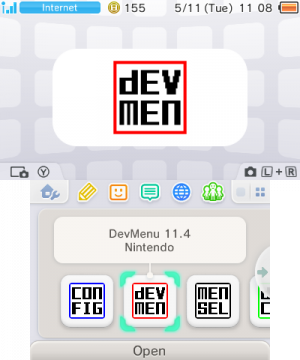
System Updaters
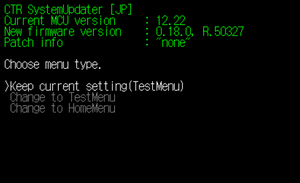
There are two kinds of system updaters for dev (panda) units, CTR System Updater (CSU) and SNAKE System Updater. As the names imply, the former is for original 3DS and the latter is for New 3DS. They are used to update the panda unit's 'firmware'/SDK Version. The romfs of the CSU contains the contents that will be installed to NAND. They contain all system titles as well as Devmenu and Config.
Home Menu
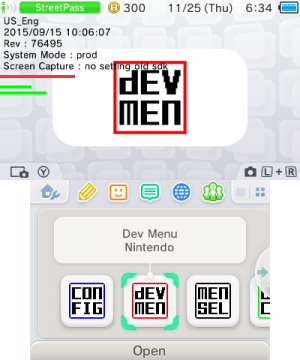
The 3DS Dev Homemenu have some features that the retail one don't have.
- Debug informations (top screen left, can be shown by pressing X+Y):
- Banner region (have every regions and languages, can be changed by pressing B+X),
- Build date,
- Homemenu rev,
- System mode (see config system mode for more infos),
- Screen capture (seems to be only for ctr debugger?),
- First red bar: Maximum level for the other bars (100%),
- Second bar: CPU processing,
- Third bar: GPU processing.
- Themes:
- The Dev Homemenu can load themes in SD:/theme/(theme name)/(theme files).
- Note that retail themes and setting dev themes in random don't work.
- Icon database and icon cache:
- You can delete them by holding X+Y button while booting homemenu.
Dev Menu

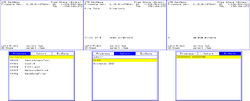
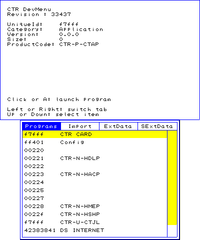
This NAND application (00040000-0ff40002) on the top screen displays the firmware and revision of the Dev Menu, the free space available on the TWL(DSi) NAND partition and SD card if present. It also provides information on the current file or device selected, as well as navigation instructions for the bottom screen.The bottom screen has three different windows, which are:
- Program - From this tab, applications can be loaded from the NAND, the SD card and the slot 1 card (only a select scope of applications, see below for Dev Menu revisions and their corresponding scope of applications). Installed software can be uninstalled by pressing X on it.
- Import - From this tab, the SD card can be browsed to select and install a .CIA file. In later revisions this was renamed to SDMC. In addition to the marked controls, also pressing X while requesting the installation of one or more CIA will delete them after a successful installation.
- HIO - "Host IO" A tab available in later revisions of the Dev Menu. Used for installing CIAs stored on the host PC, this is supported by hio services, and hio daemon on the host PC. Only usable on PARTNER-CTR (Capture+)Debugger, as HIO requires a direct USB connection with the console.
- ExtData - From this tab, the 3DS's Extdata (except NAND shared extdata) can be deleted.
- SExtData - "Shared Extdata", this feature was removed early on in the history of this app.
Titles are shown in the Program tab by Unique ID and by their Product code (CTR)/name in header (TWL); some other non-executable special titles (applets or CFAs), explicitly programmed in the specific version of DevMenu, are displayed in red.
To perform a manual update with CIAs on a dev unit, pressing Start + Y while highlighting the NATIVE_FIRM CIA will trigger an option to update firmware, thus allowing a downgrade.
Pressing L + R + Left + B + Start will, after confirmation, bulk uninstall all SDK tools. DevMenu itself will crash a few seconds later.
| SDK Version | Titles Accessible |
|---|---|
| 0.9.2 - 0.13.2 | Applications(NAND), System Applications , TWL Titles |
| 0.14.0 - 1.1.0 | Dev NAND Applications, System Applications , TWL Titles |
| 1.2.0 - 2.0.0 | Dev NAND Applications, DSiWare |
| 2.1.0 - 2.4.0 | Applications(SD), Dev NAND Applications, DSiWare |
| 3.0.0 - 3.1.0 | Applications(SD), Dev NAND Applications, Demos, DSiWare |
| 3.2.0 | Applications(SD), Dev NAND Applications, Demos, DSiWare, WebBrowser |
| 3.3.0 - ? | Applications(SD), Dev NAND Applications, Demos, DSiWare, WebBrowser, TwlNandFiler |
| 11.4 (0.24.67) | Applications(SD), Dev NAND Applications, Demos, DSiWare, WebBrowser, eShop, Miiverse, TwlNandFiler, dummy CFA |
Config

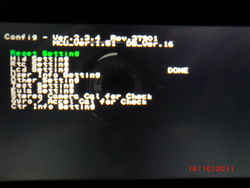
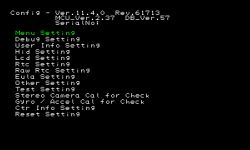
This NAND application (00040000-0ff40102) is a text-mode advanced configuration menu for the 3DS.
When open, similarly to the regular System Settings, the Home menu is not accessible, and the console is forced to be rebooted on exit (accomplished by pressing the Power button).
The functionality and menu layout of this app has changed a lot over its continuous development; some features include:
- Menu - (Home Menu/Test Menu) This function edits the configuration field containing the menu TID for dev units, allowing the user to choose between the Home Menu or the Test Menu, as the menu loaded by the NS module.
- Language - same options found in the Language section of System Settings but also has an "invalid" option
- System Mode - Changes the memory mode for the Home/Test Menu. (Launching applications will be able to override this setting)
- Prod - 64MB Memory mode (Home Menu can usually only run in this mode and most retail-looking units cannot switch out of this mode)
- Dev1 - 96MB Memory mode (No browser/Miiverse)
- Dev2 - 80MB Memory mode
- Dev3 - 72MB Memory mode
- Dev4 - 32MB Memory mode
- snake Prod - 124MB for New-3DS
- snake dev1 - 178MB for New-3DS (No browser/Miiverse)
- snake dev2 - 124MB for New-3DS
- All CTR Debuggers/Prototype units can change memory allowance. For Developer Test Units, the ability to change Memory Allowance, appears to be dependent on an option when buying the Test Unit (similar to having a choice to purchase IS-Nitro's Wireless/USG options when buying an IS-Nitro from Nintendo). If anything other than prod or dev2 is selected, menu settings are automatically changed to test menu.
- On some Test Units, it's possible to run the Home Menu outside of Prod. However, software with limited memory (such as the web browser) cannot be launched from the home menu if the home menu is outside of Prod.
- Exception handler - Selects whether to enable or disable the application's handling of exceptions that arise in the non-debug environment.
- If the application is not set to handle exceptions, the application quits when an exception occurs. - enable/disable
- Break Stop - (enable/disable) - Selects whether to enable or disable stopping the application when a break is encountered in the non-debug environment. If the application is not made to stop, it quits on a break.
- Debug Mode - (enable/disable) - Select enable or disable to enable and disable debugging functions.
- Debugging is always disabled for retail products.
- Dlp Force Child Import/Dlp Debug - (enable/disable) - normally the 3ds caches downloaded "Download Play (Dlp)" applications on the nand and only re-downloads, overwriting the cached copy if the version application being requested to downloaded is higher than what is currently present on the nand. Enabling this option forces the 3ds to download and overwrite the cached copy on the nand, regardless of the version of the application being downloaded. This is of course for testing purposes.
- Fangate Failure Emulation - Unknown, related to the external Amiibo receiver?
- Nup - Enable/disable online check for updates? Such a feature exists on WiiU
- FS Latency Emulation - Filesystem Latency, in milliseconds (0ms-2550ms). Selection is in increments of 10. (ie 0ms->10ms->20ms...)
- User Name - Console owner's "profile" nickname, unrelated to the Personal Mii
- NG Name Flag - declares whether the name is "not good", i.e. contains a banned word. Normally automatically set by System Settings after a warning; effect unknown.
- CountryId - Changes 3DS between installed countries. It can also be set to an undefined ID (255).
- RegionId - Selects the sub-location (region, state, county), if supported by the selected country. Unidentified is displayed when RegionId is set to 255.
- Hid Setting - (human interface device) Calibrates touch screen and Analog stick.
- FLICKER TOP - Bias voltage for top screen (the misattributed "contrast" or "scanline" control found as potentiometers in the battery compartment in previous color-display Nintendo portables)
- FLICKER BOTTOM - Bias voltage for bottom screen
- ABL ENABLE - "Power Save mode", adjusts backlight according to displayed image. Can also be enabled on 2DS, on which it is fully functional but the single backlight design may bring questionable results.
- LUMINANCE LEVEL - Brightness. In older versions of Config, it could be set above 5, with no further increment and resulting in crashes of the Home Menu's quick settings.
- BACKLIGHT DIMMING - Camera-controlled automatic backlight of New-3DS
- RTC Setting - (real time clock) Sets system time, with equivalent results to System Settings.
- Raw RTC Setting - Adjusts time directly on the hardware RTC. The resulting time is also displayed as a convenience. If the application being tested uses GetUserTimeOffset() to detect if the user has changed the clock, this can be used to change the clock without the application detecting it.
- Eula Setting - Input the "Agree Version", a 2-byte number representing the latest accepted version (major and minor) of the online services agreement. 00.00 is used to mean "not accepted". This setting is commonly adjusted to its maximum value, ff.ff, to bypass issues with playing foreign region games online caused by mismatching latest agreement versions.
- Sound Mode - mono/stereo/surround
- Coppacs Setting - In the U.S., a law called the Children's Online Privacy Protection Act (COPPA) requires consent from the parent or guardian for collection and use of personal information from children under the age of 13. Canada has a nearly identical law. This setting is only enabled for software for the Americas region, and when the country in System Settings is set to the US or Canada.
- Olv Access Key - Related to Olive/OLV/Miiverse. Always appears to be 0 on retail units. WiiU titles have numbers also called OLV access keys in their metadata XMLs.
- Test Setting - Verify operation and calibration of touchscreen and joystick.
- Stereo Camera Cal for Check - Apparently writes incorrect calibration data for the camera.
- Gyro / Accel Cal for Check - Apparently writes incorrect calibration data for the motion sensors.
- Ctr Info Setting - Loads settings from a ctrsetting.txt present on the SD. Such a sample file is provided in the resources/configtool folder of the SDK.
- The feature set of this option is only in most part the same as the interactive UI's, for instance ctrsetting.txt can also configure the DS Profile and Parental Controls.
- Reset Settings - Resets all settings to default. The initial configuration will be run again, but installed applications or their data will not be deleted unlike in a System Format.
CTR-SDK
Descriptions Derived from SDK 2.3.4 except where notified otherwise.
Downloadplay Client
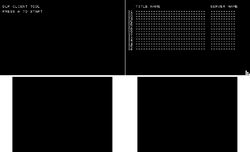

Even though a Developer 3DS has a "Download Play" application visually identical to the retail 3DS application, the text-mode "Downloadplay Client" NAND application (00040000-0ff40402) can be installed as an alternative to the regular Download Play application.
(A Developer 3DS cannot receive software from a Retail 3DS and viceversa due to different encryption keys.)
This application is used for easy testing of 3DS-mode download play 'child' apps (DS Download Play is not implemented), without the hassle of constantly re-navigating the normal Download Play interface
Network Settings
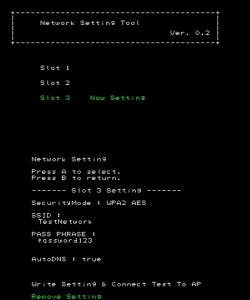

This developer NAND application (00040000-0ff40702) allows the users to directly modify the following from any of the three possible network setting 'slots'
- Security Mode :(the wireless encryption the network is using) OPEN/WEP 40bit/WEP 104bit/128bit/WPA TKIP/WPA2 TKIP/WPA AES/WPA2 AES
- SSID :(self-explanitory) maximum 32 characters
- KEY :(the key for the encrytion is here in plain text) the maximum length depends on encryption type
- AutoDNS :(whether the 3DS obtains the DNS automatically or not) |True-3DS obtains the DNS automatically|False-3DS uses the DNS server address provided by the user(it is possible to edit this here)|
At the bottom of the setting options there are two choices:
- Write Setting & Connect Test To AP - Applies the settings above and performs a connection test(note any settings made in system settings for this connection, which are not present in the above settings will be nullified, for example any proxy server settings)
- Remove Setting - removes all settings for this 'slot'
The system must be rebooted to exit this app.
SaveDataFiler

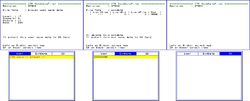
This 3DS developer NAND application (00040000-0ff40a02) allows save files and extdata to be exported and imported from an SD Card. The window has three tabs:
- User - This is where saves for 3DS-mode installed and cartridge applications can be exported to the SD Card. After the initial release, button combinations for deleting the entire save archive or resetting the secure value system for the selected title were added. The selected save archive can also be browsed by pressing A.
The entire save or individual files can be deliberately corrupted.
- ExtData - This is where application extdata can be deleted or exported to the SD Card for later use
- SD - This is where backups created through the first two tebs can be re-imported (with the options of an automatic target selection, or explicitly choosing the SD or the Game Card). Exported data can also be deleted here.
Applications are listed only by Unique Id. TWL-mode software is ignored by this application, while GBA-mode apps will always be shown as not ever having saved ("broken" and highlighted in red).
User save data is exported to sdmc:/filer/UserSaveData/YYYYMMDD(Hour)(Minute)(Second)
It creates a folder in that path and 3 files. The 2 files exported to the above path are <uniqueID>.dat and <uniqueID>_.dat while a folder named /<uniqueID>/ in that path contains <ExHeader Name>.dat
Pressing L+R+Start will, after confirmation, delete all Shared Extdata. Home Menu will crash if returned to before rebooting.
CTR MenuSelector
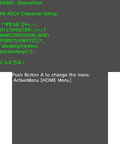

This system NAND application (00040010-0ff40b02) when loaded can change the current 'Active Menu'(being used at the moment) by editing the menu TID configuration field, allowing the user to choose between the Home Menu or the Test Menu, as the menu loaded by the NS module.
It also features a basic font test.
With the release of SDK 1.1.0, this application was superseded by the introduction of the "Menu" choice in the Config Menu and consequently removed as a standard application.
CecBoxTool
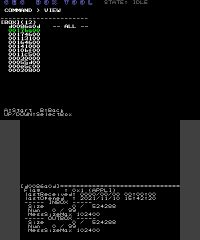
Streetpass backup and restore tool, can also delete boxes (disable StreetPass for a given software), check the number of contents of the inbox and outbox for any given box (or all of them), or reset the MAC filter.
NAND application (00040000-0ff41602)
CecLotCheckTool
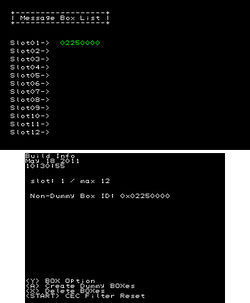

This NAND application (00040000-0f800902) is used to manage CECs (Chance Encounter Communications, AKA StreetPass) for any of the twelve possible applications registered for StreetPass, if there are any.
The BOXes are individual applications which are permitted by the user to use CECs, such as StreetPass Mii Plaza or Nintendo 3DS Sound. And as such, the boxes in this application correspond to the applications in 'StreetPass Management', in 'System Settings' (StreetPass Management is accessible from retail 3DSs). The functions of this application:
- <Y> BOX Options - this opens up a sub menu with the following options(when hovering over Nintendo 3DS Sounds BOX - the only one I can test the app with):
- <A> Create Dummy BOXes - Creates dummy BOXes to fill any unused slots. (does not overwrite any present slots)
- <X> Delete BOXes - Deletes all of the BOXes from the slots.
- <START> CEC Filter Reset - Resets 8-hour per source rate limit. The StreetPass driver runs a ENVINFO check to verify independently whether the console is not retail before applying this.
BossLotCheckTool
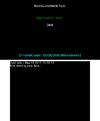

This application (00040000-0ff40e00) is used to manage BOSS (SpotPass) tasks/data for 3DS titles which utilise BOSS communications. 'Pokedex' is an application which utilizes BOSS comunications. This application also displays the 3DS's friend code, although this code is not to be confused with the 3DS's Friend Card code found in 'Friends List'. The user can browse by unique ID the 3DS titles(excluding system titles) registered to use BOSS. For each title you can view details about the downloaded 'NsData' which accompanies BOSS downloads, view the BOSS task lists (implies applications can perform more than one BOSS task). You can also view various details about each BOSS task, including:
TaskStatus : DONE? TaskExecCount : How many times the BOSS task has been executed TaskExecInterval : Period of time (in seconds) in the task is to be executed, in intervals TaskPriority : Is a number value URL : The URL to the BOSS content AP Info : NONE? TaskResultCode : Success or not HTTP_StatusCode : Self explanatory DataSize : Size of Content (in bytes) Last_Modified : Last time the BOSS content (on server) was modified StartTime : when the BOSS task was registered OptOut : Whether the user can/has opted out of BOSS communication for this task It also possible to manually execute the BOSS task from here
Stereo Camera Calibrator
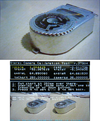

The Stereo Camera Calibrator (00040000-0ff40600), in a nutshell, allows the user to adjust the configuration of the outer cameras in relation to each other. It can be configured automatically by positioning the 3DS a set distance away from a special chart. It can also be configured manually, by setting the rotation of each camera image and the size of the right eye camera. The 3D effect can be perceived by superimposing the right eye camera image translucently with the left eye camera image or by viewing the 3D image directly by use of the parallax barrier in the 3DS Screen.
SdCardDebugUtility
A multipurpose application (00040000-07fffa00) which can:
- Fill most free space on the SD card.
- Create some sample 2D or 3D pictures.
- Create empty voice memos.
- Launch the picker applets for the former media (neither canceling nor actually selecting a file have any effect).
- Create dummy SpotPass tasks.
FragDisk
This SD application (00040000-0ff41800) creates many small files on the SD card, then deletes one out of every two to fragment the free space.
Friend Add Tool
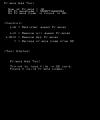
The purposes of this tool (00040000-0fe04000) are deleting all friends and/or filling the Friend List with dummy FCs, or with ones loaded from friend_code.txt on the root of the SD card.
This file must contain 1-100 friend codes, one per line. Digits may be grouped at the user's discretion with spaces, dashes, or nothing.
Friend Testing Partner
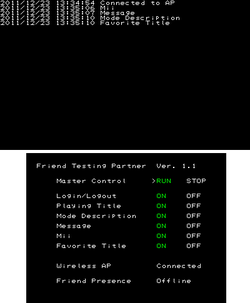

The Friend Testing Partner application (00040000-0fe00c00) is used to test/monitor the 3DS's Friend List function. It allows the user to test various functions of the 3DS's out-going Friend Card, by giving the following options:
- Master Control - (RUN/STOP) (STOP is the default setting) when ‘STOP’ is selected the 3DS Friend Card uses the user’s settings/data. When ‘RUN’ is selected the 3DS Friend Card uses the dummy settings/data chosen to test from the settings bellow.
- Login/Logout - (ON/OFF) (ON is the default setting) What effect this has on the Friend Card is not known
- Playing Title - (ON/OFF) (ON is the default setting) When ‘ON’ is selected the currently used title is ignored and a dummy applications are cycled through as the ‘Playing Title’ approximately every ten seconds in its place. The dummy applications used are the applications found in Firmware version 1.0.0-0 of a retail 3DS including the ‘Nintendo Zone viewer’ app. When ‘OFF’ is selected the currently used title (which is the Friend Testing Partner app) is used as the ‘Playing Title’
- Mode Description - (ON/OFF) (ON is the default setting) When ‘ON’ is selected the Software in Use(Playing Title) is accompanied by the Date and Time found on that user’s 3DS. The Mode Description is refreshed every ten or so seconds. When ‘OFF’ is selected the date and time on the user’s 3DS is not displayed.
- Message - (ON/OFF) (ON is the default setting) When ‘ON’ is selected the message made by the user is replaced(not overwritten as it reverts back to the user’s choice when this is ‘OFF’) by the current date and time in the format “YYYYMMDD HHMMSS”, this is refreshed every ten or so seconds.
- Mii - (ON/OFF) (ON is the default setting) When 'ON' the currently used Mii is replaced with one of 4 dummy Miis and cycles them through every ten seconds with a new dummy mii. This effect can only be seen from another 3DS not the host
- Favorite Title (ON/OFF) (ON is the default setting) When 'ON' is selected, the user’s favorite title is replaced with a dummy, which is replaced every 10 or so seconds.
Also this application allows the user to monitor the whether the 3DS is online or not and whether the 3DS’s Friend Presence is online or offline. Every time a dummy setting is refreshed it is displayed on the top screen with a time stamp.
Game Coin Setter

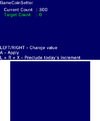
This application (00040000-0ff40d00) is used to set the Play Coin count on the 3DS. Obviously this was created so a developer can test parts of their game in which the player can exchange earned play coins for in-game content or similar. It has a very simple interface showing the current play coin count and the adjustable option, the target coin count. These are the controls with explanation of each:
- LEFT/RIGHT - using the D-pad only to adjust the 'Target Count' to a number between 0-300.
- A - Sets the 'Current Count' (amount of play coins the system has) to the user selected 'Target Count' (the user specified amount of play coins)
- L+R+X - "Preclude today's Increment" Sets byte 6 of the play coin database so that no coins will be earned through walking for the current day anymore.
PedometerHistoryChanger
A tool (00040000-0ff30300) to preview on-screen, or export to SD, pedometer data.
The format of PedometerExport.csv is: year,month,day,hour,steps during that hour.
Data can be read from an equally formatted PedometerImport.csv, replacing the entire pre-existing history or only conflicting hours at the user's discretion. History on internal storage can be cleared, too.
IR Communication Checker
This application has title ID 00040000-0f804900 and cannot be closed (apart from forcing a power cycle).
Counts data seen by the infrared port. It doesn't have to be valid, as it happily measures a camera flash...
EcDevTool

This multipurpose tool (00040000-0ff41b00) provides several features propedeutical to simulating software sales:
- Add balance: self explanatory, not functional on the production eShop server
- Delete title right: Local and (apparently) server-side ticket uninstaller
- Delete eshop account: self explanatory, sometimes functional on the production eShop server
- Change country - apply a country change without going through the multiple warnings present in the retail eShop app
- Change tax address - zipcode entry (USA and Canada only).
Dummy Nintendo eShop
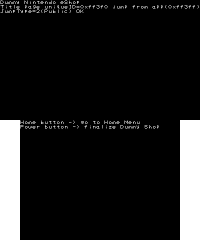
This region-specific application exists to debug API( JumpToEshop() ) on the 3DS. This was created so a developer can test parts of their game in which the player can preview or purchase titles within a game. It is mainly used in conjunction with Downloadable content. It has a very simple interface showing the reason for its existence and controls for exiting to the home menu or finalizing the Dummy Shop. The Dummy Nintendo eShop also shares the same Title ID and Unique ID as the Retail Nintendo E-Shop.
FangateFwUpdater
00040000-0ff41f00 is a tool for updating or destroying (thus enabling downgrade of) the external NFC reader/writer's firmware. This tool cannot be used with SNAKE development devices or SNAKE development tools. It operates only with CTR development devices and CTR development tools.
NoftWriter
(00040000-0f807f00) Browse the SD card for Amiibo images, and flash them to non-locked tags. After programming, the tag may be left locked or not at the user's discretion.
NfpSdmcTool
(00040000-0ff42100) Can read, write, and modify NFP tag data.
NfpManager
A multipurpose Amiibo tool, having the title ID of 00040000-0ff41e00.
The eventual connection to an external NFC adapter, to the Amiibo, and to its contents can all be enabled or disabled separately.
Amiibo data (owner, save file, or both) can be deleted or replaced.
The local NAND backup of scanned Amiibos can be deleted too.
NfpUtility
A simplified, bulk Amiibo checker (00040000-0ff42000): just hold a supported tag over the NFC reader to view a summary of its character identity and owner info.
UdsLocalIdChecker
A scanner for local, console-to-console networks. Its title ID is 00040000-0ff3ff00.
TWL Development Tools
These are DSi/DS mode development tools repackaged into a CIA, for installing to the TWL NAND.
NINTENDO DS - WMtest
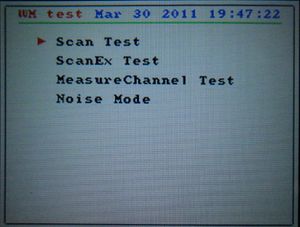
This application is a TWL(DSi) application compiled for use on the 3DS. It is an wireless test tool with its uses explained below:
- Scan Test - Scans Wireless channels 1-13 (can be focused on one specific channel) for broadcasting stations. It can detect two types of broadcasting stations:
- Wifi Access Points - Giving the Mac Address, Broadcasting Channel, 'c', and the SSID
- DS Stations such as DS Download stations and Pokemon distributors - Giving the Mac Address, Brodcasting Channel, TGID and GGID
- ScanEx Test - and has two Scan Types. Passive which lets you individually scan channels 1-13 (only one at at time) and the DS distribution channels (1,7,13 all at once). And Active which scans all 13 channels at once. when it finds a channel it prints on the bottom screen next to 'Found' 'bssDescCount='
- MeasureChannel Test - not quite sure what this does but it for a given channel it gives a ratio(in percentage form), which it finds in its allocated test time ranging from 10ms to 1000ms. And for every interval of time which is specified, it tests and gives a ratio.
- Noise Mode - Seeks wireless channels in which to make wireless noise (This is not made very clear on the app). You can specify the:
Channel where the scanner will seek to make noise
Noise Rate, ranging from 0% to 100%
Frequency, ranging from 10ms to 50ms
Seek Mode, ranging from 1000ms to 1500ms
When the settings are chosen the top screen has two counters which display 'Noise ON count' and 'Noise OFF count' the counters are affected by the noise rate. Starting at 0% the 'Noise ON count' does not change but as the Noise rate gets closer to 100% the count moves and gets faster as Noise rate reaches 100%. For 'Noise OFF count' it is the exact opposite to the ' Noise ON count' in regards to counting.
TWLNandFiler
Browse, export, delete and import save archives from TWL Nand. Includes a basic hex viewer.
NW4C
NintendoWare for CTR is comprised of tools that deal with creating effects, fonts, models, layouts, sound, and text. There are CTR versions of some of the viewers.
H3D Model Viewer



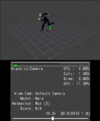
Used for viewing Binary CTR Models (.bcmdl): the model can be viewed from any angle or scale, the perspective is controlled by the circle pad and directional buttons.
Models need to be loaded into memory through Host IO, so this application is only usable for its intended purpose on a CTR-PARTNER (Capture-)Debugger; on a CTR-PARTNER Capture or Test Units, the model is restricted to three coloured lines depicting the 3 dimensions (x,y,z).
There is also a Windows port of this program, running in a specialized proprietary emulator.
Layout Viewer


Used for viewing Binary CTR Layouts (.bclyt). It is used with CTR-PARTNER to load layouts into RAM.
Effect Viewer
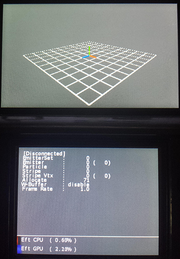

Mobiclip suite
Along with (but separately from) the Mobiclip encoder, Nintendo offers to developers:
3D Movie Player
A simple but polished gamecard or SD application (00040000-00036A00) that, comparably to retail multi-video titles (such as "Shaun The Sheep"), allows its user to select moflex files directly from the root of the SD card, then watch them (complete with seek bar, FF/pause/REW buttons, and an auto-dimming user interface!)
